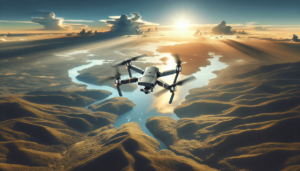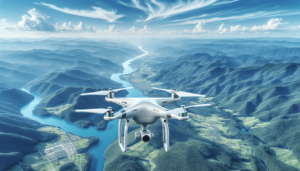Have you ever looked up at the sky and thought, “What would this view look like from above?” We’ve all been there, standing on a beach or atop a mountain, curious about the world beyond our everyday horizons. Aerial photography answers that call of curiosity, offering a bird’s-eye perspective of our world. It’s like seeing the earth in high definition for the first time. But let’s be real, it’s not just about snapping a picture—it’s about capturing a story. For those of us who want to embark on this adventurous path, what do we really need in our toolkit?
In this quest for the perfect aerial shot, let’s explore the must-have tools that can make our photography journey not only fruitful but also more enjoyable. Let’s chat about the ground rules (pun intended) of capturing the sky.
The Importance of Having the Right Tools
Without the right gear, aerial photography can feel like trying to paint the Mona Lisa with a toothbrush. Sure, it might be technically possible, but the results probably won’t meet your lofty expectations. Our shared ambition is to capture those breathtaking aerial views with precision and clarity. That’s why having the right equipment is non-negotiable.
Whether you’re an experienced photographer ready to take it to the skies, or a hobbyist looking to enhance your skill set, our guide will equip us with the knowledge to make wise decisions. Why stumble around when we can walk the path together, armed with expert insights?
Drone: The Heart of Aerial Photography
So, let’s chat about the elephant in the room—or should we say, the drone in the sky. As the backbone of aerial photography, drones open up a whole new realm of possibilities. It’s like having a superhero sidekick that can fly. Choosing the right drone can feel a bit like dating; there are so many options, and each one offers a different kind of promise.
Picking the Right Drone
When it comes to choosing a drone, we should consider several factors. Camera quality is paramount; without a decent camera, even the best flying skills won’t result in stunning photos. Consider drones equipped with 4K cameras to capture the finest details. Stability is next in line—our drone should handle windy conditions without turning our photographs into abstract art. Let’s not forget portability. Whether we’re heading into the wilderness or just to the local park, shelling out for a drone that’s easy to transport is money well spent.
Here is a simple table to break down these considerations:
| Feature | Importance | Why It Matters |
|---|---|---|
| Camera Quality | High | More pixels mean we can capture more detail in our photographs. |
| Stability | High | A stable drone gives us clearer images, even in less-than-ideal weather. |
| Portability | Medium to High | Easier to carry means more opportunities to capture the perfect shot. |
Recommended Drones
There are a few popular models that we believe give the best bang for our buck. The DJI Mavic Air 2 is versatile, offering excellent camera quality and portability. If we’re budget-conscious, the Holy Stone HS720 has a good balance between cost and features, without skimping on essential functionalities.
![5 Must-Have Tools For Aerial Photography [Expert Buyer’s Guide] 5 Must-Have Tools For Aerial Photography [Expert Buyer’s Guide]](https://droneaperture.com/wp-content/uploads/2025/01/5-must-have-tools-for-aerial-photography-expert-buyers-guide-1024x585.png)
Gimbals: Keeping the Camera Steady
Once the drone is airborne, next comes ensuring the footage isn’t shaky. Enter the gimbal—the unsung hero of smooth aerial shots. It’s like having a tiny on-board film director making sure every scene is as smooth as possible. Gimbals stabilize our camera, allowing it to maneuver smoothly even with the drone ricocheting through turbulent skies.
Why We Need a Gimbal
The essence of a gimbal isn’t just to stabilize. It’s about producing cinematic quality that sets our shots apart from amateur video. Think of a gimbal as the finishing touch to an haute couture outfit. Essential, stylish, and utterly transformative.
Let’s take a look at a few top choices:
- DJI Ronin-S: Best for adventurous souls who face unpredictable weather conditions.
- Zhiyun Crane 3: Offers flexibility with heavier camera setups, ideal for professional-grade shots.
Lenses: Expanding Our Perspective
Lenses act like magic glasses, allowing us to see the world in different ways. And much like magic, the right lens can transform a simple image into an extraordinary one. The expansive nature of aerial photography means we’re often focusing on wide landscapes or zooming into specific details.
Choosing the Right Lens
Wide-angle lenses are ideal for capturing large vistas, giving us that dramatic scope. Conversely, telephoto lenses allow us to zoom in and showcase details that would be lost to the naked eye. Consider these questions: Are we shooting vast landscapes, or are we hyper-focused on unique details? Our answer will guide our lens choice.
A quick breakdown of lens types and their uses is shown below:
| Lens Type | Ideal Use Case | Description |
|---|---|---|
| Wide-angle | Landscapes | Covers more area in a single shot. |
| Telephoto | Detailed shots | Zooms in on distant subjects. |
| Prime lenses | Versatility | Fixed focal length but superior image quality. |
Suggestions for Lenses
Investing in lenses like the Canon EF 16-35mm f/2.8L III provides exceptional quality for wide views. On the other hand, lenses like Nikon AF-S NIKKOR 200-500mm f/5.6E ED VR offer remarkable telephoto capabilities.
![5 Must-Have Tools For Aerial Photography [Expert Buyer’s Guide] 5 Must-Have Tools For Aerial Photography [Expert Buyer’s Guide]](https://droneaperture.com/wp-content/uploads/2025/01/5-must-have-tools-for-aerial-photography-expert-buyers-guide-1-1024x585.png)
Filters: Enhancing the Imagery
Filters can often make the difference between a good photo and a great one. Like a sprinkle of salt on bland pasta, they enhance and elevate imagery. Neutral density filters, polarizers, or graduated filters each have a role in perfecting shots.
Types of Filters and Their Benefits
- Neutral Density Filters (ND): Perfect for those bright days when the sun just won’t quit. They help control exposure.
- Polarizers: Enhance colors and reduce reflections. Useful when we’re shooting bodies of water or windows from above.
- Graduated Filters: These help balance lighting when shooting skies and landscapes together.
We can rely on popular brands like Tiffen and Hoya, known for their affordable yet high-quality filter options.
Editing Software: The Darkroom of the Digital Age
Once we’ve captured those stunning shots, it’s time to polish them up with editing software. Adobe Photoshop and Lightroom are like our digital paintbrushes. Used wisely, they allow us to bring out the colors and textures of our images.
Why Editing Software is Essential
Editing software helps correct minor mistakes, like overexposure or pesky dust spots. Plus, it gives us creative control—transforming each image to reflect our unique artistic vision. It’s akin to cooking; while fresh ingredients shine, seasoning and preparation elevate the flavors.
Recommended Software
- Adobe Lightroom: Offers a comprehensive toolset for photographers, allowing us to fine-tune images with precision.
- Adobe Photoshop: Perfect for more elaborate edits, adding or removing elements, or creating composites.
Bringing It All Together
In this aerial adventure, having the right tools makes all the difference. The drone elevates us, the gimbal steadies us, lenses focus us, filters enhance us, and editing software refines us. Together, they form a symphony of devices that allow us to capture the world from new and exciting angles.
With the right equipment, the stories we can tell from above know no bounds. Now, if that doesn’t have us all ready to take flight, we don’t know what will. Let’s set our sights high and capture the world as it’s meant to be seen—majestic, vast, and breathtaking from the skies.
![7 Essential Aerial Photography Tips For Beginners [2025]](https://droneaperture.com/wp-content/uploads/2025/01/7-essential-aerial-photography-tips-for-beginners-2025-1-300x171.png)

